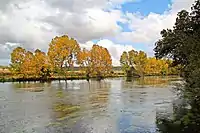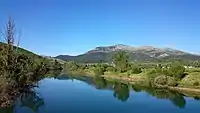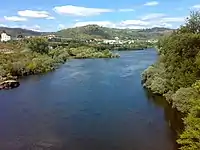List of rivers of Spain
This is an incomplete list of rivers that are at least partially in Spain. The rivers flowing into the sea are sorted along the coast. Rivers flowing into other rivers are listed by the rivers they flow into. Rivers in the mainland Iberian Peninsula can be divided into those belonging to the Mediterranean watershed, those flowing into the Atlantic Ocean and those emptying into the Cantabrian sea (a marginal sea of the Atlantic off the northern coast of the Iberian peninsula).
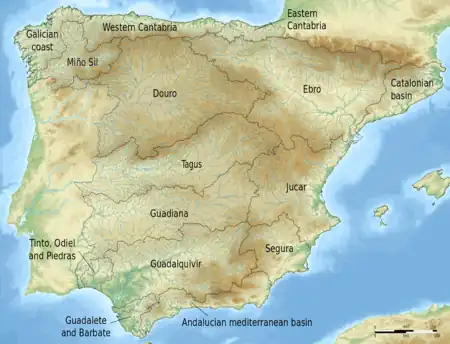
Tributaries are listed down the page in an downstream direction. The main stem river of a catchment is labelled as ms, left-bank tributaries are indicated by l, right-bank tributaries by r. Where a named river derives from the confluence of two differently named rivers these are labelled as ls and rs for the left and right forks (the rivers on the left and right, relative to an observer facing downstream). The transboundary rivers partially running through Portugal or France and/or along the borders of Spain with those countries are labelled as int.
The list begins with the northernmost item of the Mediterranean watershed (close to the French border) and moves clockwise around the Iberian Peninsula.
Outside from the Iberian peninsula mainland, streams in the Canary Islands, the Balearic Islands, Ceuta and Melilla are seasonal watercourses. The Santa Eulàlia river in Ibiza was traditionally considered as the single proper 'river' in the Balearic Islands, but it lost its constant flow by the late 20th-century.[1]
Mediterranean watershed
Catalan basins
This includes the basins emptying in the Mediterranean Sea located in the coastline north from the Ebro. It has to be noted this leaves out the Garonne and the Ebro, both draining parts of Inner Catalonia, as well as small streams in Catalonia emptying in the Mediterranean south from the Ebro.
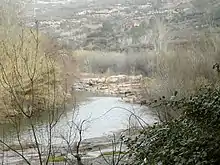
Ebro
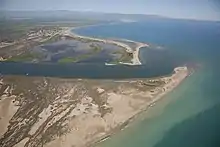
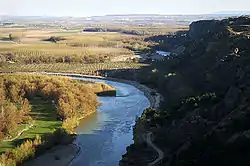
- Ebro (ms · 910 km)
- Híjar (r · 28 km; aside from joining the Ebro near Reinosa, the upstream traditional source of the very same Ebro in Fontibre han been recently redescribed as a water spring of the Híjar)[2]
- Rudrón (r · 35 km)
- Oca (r · 72 km)
- Nela (l · 74 km)
- Bayas (l · 58 km)
- Zadorra (l · 88 km)
- Tirón (r · 64 km)
- Najerilla/Neila (r · 73 km)
- Ega (l · 115 km)
- Cidacos (r · 79 km)
- Aragón (l · 197 km)
- Alhama (r · 79 km)
- Queiles (r · 42 km)
- Arba (l · 80 km)
- Jalón (r · 224 km)
- Huerva (r · 135 km)
- Gállego (l · 203 km)
- Guarga (l · 40 km)
- Sotón (l · 52 km)
- Aguasvivas (r · 103 km)
- Martín (r · 98 km)
- Escuriza (r · 35 km)
- Guadalope (r · 182 km)
- Bergantes (r · 57 km)
- Segre (l · int · 261 km)
- Valira/Gran Valira (r · int)
- Ribera Salada (l)
- Rialb (r · 30 km)
- Llobregós (l)
- Noguera Pallaresa (r · 143 km)
- Sió (l)
- Corb (l)
- Noguera Ribagorçana/Noguera Ribagorzana (r · 130 km)
- Noguera de Tor (l)
- Set (l)
- Cinca (r · 177 km)
- Matarranya/Matarraña (r · 101 km)
Levante
This roughly includes the basins emptying in the Mediterranean Sea ranging from those emptying south from the Ebro to the intermittent seasonal watercourses characteristic of the areas near the border between Murcia and the Andalusian province of Almería.
- Cenia/Sénia (ms)
- Mijares/Millars (ms · 156 km)
- Albentosa (r · 32 km)
- Montán (r)
- Villahermosa (l)
- Rambla de la Viuda (l · 81 km)
- Monleón/Montlleó (rs · 83 km)
- Rambla Carbonera (ls)
- Lucena (r · 33 km)
- Belcaire (ms)
- Turia/Guadalaviar (280km)
- Alfambra (l · 99 km)
- Camarena (l)
- Ebrón (r)
- Bohílgues/Vallanca (r)
- Tuéjar (l)
- Júcar/Xúquer (ms · 498 km)
- Huécar (l · 31 km)
- Valdemembra (l · 103 km)
- Cabriel (l · 263 km)
- Albaida (r · 38 km)
- Magre/Magro (l · 125 km)
- Cànyoles/Cáñoles (l · 63 km)
- Serpis (ms · 75 km)
- Vinalopó (ms · 82 km)
- Segura (ms · 325 km)
- Mundo (l · 108 km)
- Alhárabe/Moratalla (r)
- Mula (r · 61 km)
- Guadalentín/Sangonera (r · 95 km)
Andalusian Mediterranean basins
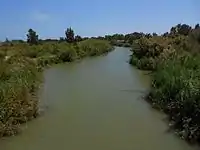
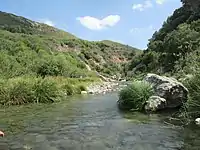
- Almanzora (ms · 105 km)
- Andarax (ms · 62 km)
- Adra (ms · 47 km)
- Guadalfeo (ms · 72 km)
- Vélez (ms · 36 km)
- Guadalmedina (ms · 48 km)
- Guadalhorce (ms · 154 km)
- Guadalteba (r · 43 km)
- Guadiaro (ms · 79 km)
- Guadalevín
- Genal (l · 48 km)
- Hozgarganta (r · 48 km)
Atlantic watershed
This section features the rivers flowing into the Atlantic Ocean, ranging from the Punta de Tarifa (the meeting point of the Mediterranean and the Atlantic) to the Punta de Estaca de Bares (the conventional boundary between the Atlantic of the Cantabrian Sea, one of the former's marginal seas).
Gulf of Cádiz
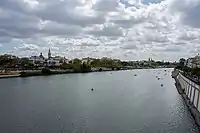
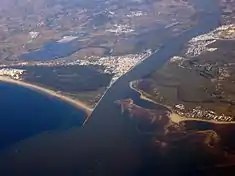
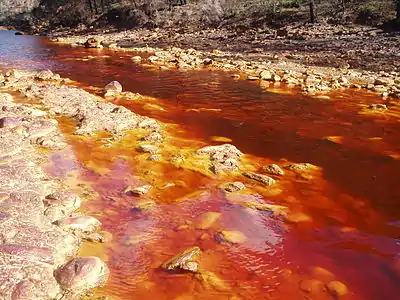
- Guadalete (ms · 173 km)
- San Pedro
- Guadalquivir (ms · 657 km)
- Guadiana Menor (l · 182 km)
- Guadalimar (r · 167 km)
- Guadalén (r · 127 km)
- Guadalbullón (l · 74 km)
- Rumblar (r · 70 km)
- Jándula (r · 90 km)
- Yeguas (r · 76 km)
- Guadalmellato (r · 111 km)
- Guadajoz (l · 114 km)
- Guadiato (r · 123 km)
- Bembézar (r · 111 km)
- Genil (l · 337 km)
- Darro (r)
- Corbones (l · 58 km)
- Viar (r · 117 km)
- Rivera de Huelva (r · 61 km)
- Guadaíra (l · 89 km)
- Guadiamar (r · 60 km)
- Tinto (ms · 93 km)[n. 1]
- Odiel (ms · 121 km)[n. 2]
- Piedras (ms)
- Guadiana (ms · int · 818 km)
Tagus
- Tagus/Tajo/Tejo (ms · int · 1007 km;[3] of which 816 km run through Spain and 47 km through the Portugal–Spain border)[4]
- Gallo (l · 98 km)
- Guadiela (l · 117 km)
- Cuervo (l · 36 km)
- Escabas (l · 62 km)
- Trabaque (l · 40 km)
- Mayor (l · 71 km)
- Jarama (r · 194 km)
- Algodor (l · 96 km)
- Guadarrama (r · 96 km)
- Aulencia (l)
- Pusa (l · 67 km)
- Alberche (r · 182 km)
- Tiétar (r · 170 km)
- Garganta Torinas (l)
- Ramacastañas (r)
- Arenal (r)
- Guadyerbas (l · 45 km)
- Garganta de Santa María (r · 27 km)
- Garganta de Alardos (r)
- Garganta de Cuartos (r)
- Almonte (l · 160 km)
- Tamuja (l · 84 km)
- Gibranzos (r · 37 km)
- Magasca (r · 52 km)
- Guadiloba (l · 56 km)
- Tamuja (l · 84 km)
- Alagón (r · 201 km)
- Ladrillar (r)
- Hurdano (r · 37 km)
- Jerte (l · 70 km)
- Árrago (r · 71 km)
- Rivera de Gata (r · 40 km)
Douro
- Douro/Duero (ms · int · 897 km of which 572 km run through Spain and 112 km through the Portugal–Spain border)[5]
- Duratón (l · 103 km)
- Cega (l · 133 km)
- Cerquilla River (30 km)
- Pirón (l · 88 km)
- Pisuerga (r · 275 km)
- Adaja (l · 163 km)
- Zapardiel (l · 105 km)
- Valtodano (l · 17,5 km)
- Trabancos (l · 81 km)
- Regamón (l · 29 km)
- Guareña (l · 63 km)
- Valderaduey (r · 146 km)
- Navajos/Ahogaborricos/Bustillo (l · 51 km)
- Sequillo (l · 115 km)
- Salado (r · 35 km)
- Esla (r · 275 km)
- Bernesga (r · 76 km)
- Rodiezmo de la Tercia (r)
- Torío (l · 60 km)
- Cea (l · 175 km)
- Órbigo (r · 97 km)
- Omaña River (rs · 50 km)
- Luna (ls)
- Tuerto (r · 64 km)
- Eria (r · 95 km)
- Tera (r · 138 km)
- Negro (l · 51 km)
- Castrón (r) · 41 km)
- Aliste (r · 68 km)
- Mena (r) · 21 km)
- Bernesga (r · 76 km)
- Tormes (l · 247 km)
- Águeda (l · 132 km)
- Huebra (l · 122 km)
- Tâmega/Támega (r · int · 145 km of which 52 km run through Spain)[6]
Minho-Sil
- Minho/Miño (ms · int · 345 km of which the last 75.5 km form the Portugal–Spain border)[8]
Cantabrian watershed
This includes the rivers flowing into the Cantabrian Sea[9] (as well as in the case of the Garonne the wider Bay of Biscay) east of the Punta de Estaca de Bares. They are chiefly short streams streaming down the Cantabrian Mountains and the southern slopes of the Pyrenees.
- Eo (ms · 79 km)
- Nalón (ms · 129 km)
- Narcea (l · 107 km)
- Navia (ms · 159 km)
- Sella (ms · 56 km)
- Dobra (r)
- Deva (ms · 60 km)
- Cares (r · 50 km)
- Nansa (ms · 50 km)
- Saja (ms · 58 km)
- Besaya (r · 47 km)
- Pas (ms · 50 km)
- Pisueña (r · 33 km)
- Miera (ms · 39 km)
- Asón (ms · 39 km)
- Gándara (r)
- Nervión/Nerbioi (ms · 69 km)
- Oria (ms · 66 km)
- Leitzaran/Leizarán (r; 37 km)
- Urola (ms · 55 km)
- Urumea (ms · 40 km)
- Bidasoa (ms · int · 41.6 km of which the last ones form the France–Spain border)[10]
- Garonne/Garona (ms · int · 602 km of which roughly 40 km run through Spain)[11][n. 5]
See also
References
- Informational notes
- It empties in the Ría de Huelva, the same estuary as the Odiel · the Tinto and the Odiel are often considered part of the same river system.)
- It empties in the Ría de Huelva, the same estuary as the Tinto · the Tinto and the Odiel are often considered part of the same river system.)
- Not to be confused with the equally named Mao, a tributary of the Cabe (and thus, second-order tributary of the Sil).
- Not to be confused with the equally named Mao, a first-order tributary of the Sil.
- The Garonne is a river that flows into the Gironde estuary in the Atlantic Ocean. Running roughly 40 km through Spain along its upper course, it is the only river in Spain that drains North of the Pyrenees into the Atlantic.
- Citations
- "Armengol cambia la geografía de Baleares tras 'inventarse' 90 ríos". El Mundo (in Spanish). 2018-03-30. Retrieved 2020-01-21.
- Aragón, Heraldo de. "Ya ni el Ebro nace en Fontibre". heraldo.es (in Spanish). Retrieved 2020-01-22.
- Nacional, Instituto Geográfico. "Datos geográficos y toponimia. Vertiente atlántica". Centro Nacional de Información Geográfica (in European Spanish). Instituto Geográfico Nacional. Archived from the original on 2020-01-22. Retrieved 2020-01-21.
- Miñana, Fernando (23 October 2019). "España juega con el grifo". Hoy.
- Hervás, Juan Carlos (2015-10-12). "Medrano pide al PP que apoye en el Senado el "Itinerario virtual del Duero"". El Miron de Soria (in Spanish). Retrieved 2020-01-21.
- "El plan director del Támega constata la contaminación del río en Verín". La Voz de Galicia (in Spanish). 2016-10-04. Retrieved 2020-01-21.
- "Anejo II. Inventario de recursos hídricos naturales" (PDF). Confederacion Hidrográfica del Miño-Sil. p. 10.
- Pozo Serrano, María del Pilar (1999). "El régimen jurídico de los cursos de agua hispano-portugueses". Anuario español de derecho internacional (15): 326. ISSN 0212-0747.
- "Datos geográficos y toponimia. Vertiente cantábrica". Centro Nacional de Información Geográfica. Instituto Geográfico Nacional. Archived from the original on 2020-01-21.
- "Río Bidasoa - WebCHC". www.chcantabrico.es. Retrieved 2020-01-21.
- "La Val d'Aran vista desde el Garona". La Vanguardia (in Spanish). 2018-04-05. Retrieved 2020-01-21.
.jpg.webp)
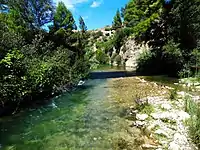
.JPG.webp)

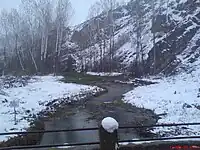
.jpg.webp)
